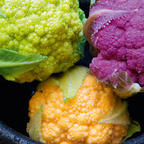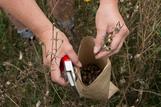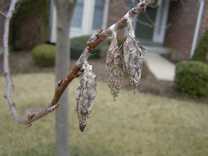|
Ozark Green Thumb BCMG Monthly e-Newsletter |
|
|
|
AUGUST GARDEN CHECKLIST
For more information on any of the above points, contact the U of A Division of Agriculture Cooperative Extension office at 425-2335.
0 Comments
 We’ve all been admonished to eat our vegetables, and sometimes we even follow that sage advice. I’m a big fan of most vegetables and especially like cabbage, broccoli, kale and Brussels sprouts, but their pale cousin, cauliflower, has been harder to warm to. But the world, she is a-changing, and the white curds of cauliflowers are now available in designer shades. Cauliflower is closely related to broccoli, both being members of the crucifer family and classified as Brassica oleracea Botrytis Group. All of the crucifers – everything from cabbage to kohlrabi – are native to the Mediterranean region and derived from ancestral wild cabbage that still grows in the region. Over the past 4,000 years, variants of the wild species have been selected and modified by farmers in what is one of the first examples of extreme genetic modification. Like other crucifers, cauliflower is a biennial. To get it to flower plants must go through a winter with the typical 4-petaled yellow or white flowers produced on elongating shoots in the spring. However, cauliflower is a more temperamental crucifer than most. It is the most freeze sensitive of the crucifers and also intolerant of heat and drought. The edible head (curd) of cauliflower is formed from fused flowers. White curds are the typical form and have been described in early writings since at least 600 B.C. The now war-ravage country of Syria was the source of some of the first forms of cauliflower grown in Spain that eventually spread to the rest of Europe. Early Italian cauliflower cultivars have included color variants but it was not until 1970 with the chance discovery of an orange-headed mutation in a Canadian cauliflower field that the story of the modern colored forms began. A sample was collected of the plant, it was propagated and eventually made its way to the National Vegetable Research Center in England. Researchers there knew of the interest Michael Dickson, a Cornell University crucifer breeder working with cauliflowers, so they sent him samples. In 1989 Dickson released the orange headed breeding lines to commercial vegetable seed companies. The orange clone Cheddar was released in 2004. Orange cauliflower has a high vitamin A content. Green cauliflower lines began appearing about 1990 and contain low concentrations of chlorophyll in the curd to produce the green shading. The purple cauliflowers rely on the anthocyanin pigment found in red cabbage to provide its color. Cauliflower is low in calories and carbohydrates, making it a substitute for starchy foods such as potatoes, rice and pasta. Cauliflower can be grown as a spring or fall crop in Arkansas. Seeds are started indoors in the winter with the planting date delayed until about two weeks before the anticipated last frost date. White curded cultivars such as Snowball mature in about 10 weeks, so they should finish before the worst of the summer heat. Fall crops can be planted in August but careful attention must be paid to watering to assure success. For best results a uniform moisture and fertility regime must be maintained to assure successful production. Some cauliflower clones are said to be “self-blanching,” a reference to the fact that the uppermost leaves curve inward and shield the developing curd from the direct rays of the sun. For older cultivars blanching is done by tying together the uppermost leaves in a loose bunch when the curd is 2-3 inches across. This reduces the chance of sunburn and prevents the development of chlorophyll, which can lead to an off taste. Blanching is more important for the spring crop than the fall crop. Being a crucifer, cauliflowers are plagued by a number of diseases and insect pests. The cabbage looper is the most serious insect pest and early infestations can result in serious defoliation, which reduces curd development. BT, an organic insecticide, has proven effective in controlling this pest.
For more information about horticulture or to see other Plant of the Week columns, visit Extension's Web site, www.uaex.edu, or contact your county extension agent. The Cooperative Extension Service is part of the U of A Division of Agriculture.  County fairs are a curious amalgam of nostalgic and contemporaneous events that remind us of the way it was in rural America in a supposedly simpler time. Competition to have the biggest and best in the county is keen and comes in many forms. The giant sunflower heads the list of the most unusual in plant exhibits. These sunflower giants may have been grown down on the farm in bygone days, but they were in grandmother’s flower garden not in grandfather’s fields. The story of how this all-American weed became an important crop plant bears a closer look. The sunflower, Helianthus annuus, is a member of the daisy family with wide distribution across the United States. Sunflowers are large plants with two distinct architectures. The wild type can grow 10 to 12 feet tall with considerable branching, each of which terminates in 5-inch diameter blooms. The cultivated sunflower has lost the ability to branch and can grow to 15 feet tall with a single flower head atop the stout stem that may be the size of a garbage can lid. When European explorers arrived in the 1500s, they found native Americans growing this unbranched mutant wherever they went. Sunflower never became a part of the diet of the more advance cultures of southern Mexico.
A sunflower bloom is not really a flower but a specialized flat inflorescence that bears hundreds of tiny individual flowers. When the sunflower arrived in Europe, it was a big hit because people were amazed by the rank growth and gaudy spectacle of the flower. It quickly spread throughout Europe but remained a curiosity in the garden. By the early 18th century, the seeds were considered nutritious poultry food, but otherwise the plant remained a novelty of little value. The Russians were credited with the rise of sunflowers to agricultural stardom. They developed two types of sunflowers. The large-seeded types were developed as a snack food, much as peanuts were used in the rest of the world. The sunflowers grown in the U.S. today are descendants of varieties the Russians sent us at the close of the 19th century. The more important sunflowers though were the small seeded oil types. During the Communist era, Russian agriculturists increased the oil content of these selections from about 28 percent to over 50 percent. The oil was used in everything from cooking to paint and by 1980 sunflower was the second most important crop oil in the world. After all of those years being berated for having named a weed the state flower, Kansans could finally hold their head up proudly. During the 1990s sunflowers were rediscovered by American gardeners and interior designers. The rise in the specialty cut flower market - especially at farmers markets around the nation - has lead to the development of a number of sunflower selections suitable for this purpose. The sunflower motif became popular theme in interior decoration and has been plastered on about every imaginable surface. Using sunflowers in the garden requires special consideration. They require full sun and a fertile, moist soil to reach their full potential. Unlike most garden plants, sunflowers should never be grown in a pot but instead the seeds planted in hills containing three to five seeds directly where you want the plant. Thin the hills to one vigorous seedling when the seeds emerge. Plant the hills 2 feet apart to achieve the largest possible plants. Because sunflowers just produce a single flower, their bloom time is short. Plant new hills every three to four weeks to ensure continual bloom. By: Gerald Klingaman, retired Extension Horticulturist - Ornamentals Extension News - September 6, 2002  This is an easy and tasty dip for a change from sour cream and onion dip. Serve with vegetables and crackers. Ingredients
In a medium bowl, combine cheese, yogurt, buttermilk,
lemon juice, chives and mix well. Season to taste with salt and pepper. Makes about 1 1/4 cups.  Collecting flower seeds from your favorite plants is a fun and rewarding pastime. Growing plants from seed is not only easy but also economical. Once you have the method down you will have a cost efficient way of ensuring a garden full of beautiful blooms year after year. Seed harvesting provides an opportunity to preserve your beautiful garden flowers to replant next year or share with friends and family. Some gardeners also enjoy developing their own seed strains or hybridizing their plants by seed saving. Knowing when to harvest garden seeds is the first step to saving plants for future use. Once flowers begin to fade at the close of the season, most flower seeds are ripe for picking. Seed harvesting should be done on a dry and sunny day. Once seedpods have changed from green to brown and can be easily split, you can begin collecting flower seeds. Many people choose to gather seeds while deadheading plants in the garden. Always harvest seeds from your best performing plants. When you’re ready for seed harvesting, you’ll need to know the best method on how to collect flower seeds. Use clean and sharp garden scissors to cut the pods or seed heads from the plant and place them into a paper collection bag. Label all of your bags so that you do not forget which seeds are which. It is important to use only paper bags, as seeds can spoil in plastic. Once you have collected your seeds, you can spread them out on a screen or a piece of newspaper and dry them at room temperature for a week. So now that your seeds have been harvested, it’s time to learn how to store flower seeds to ensure they will be at their optimal best for planting next season. Brown paper bags or envelopes are great to store dry seeds. Label all envelopes accordingly. Store seeds in a cool and dark spot for the winter. A temperature around 40 F. (5 C.) is best. Do not crush or damage seeds or allow seeds to freeze or overheat while in storage. Keep seeds dry at all times. By Susan Patterson, Master Gardener
Gardening Know How  Dinner is on the table in less than 30 minutes with this simple recipe. Fresh rosemary and balsamic vinegar prove to be a perfect pair in this easy marinated pork chop recipe. Serves: 4 Ingredients:
Directions:
1. Place pork chops in a medium sized shallow dish and sprinkle with oil, vinegar and rosemary. Season chops with salt and pepper. Turn to coat evenly and let stand at room temperature while grill heats. 2. Set grill at 350 degrees F. Grill pork chops 10 minutes per side, or until internal temperature reaches 160 degrees F. 3. Serve it with grilled potatoes and a tossed salad.  Close-up of bagworms (Lepidoptera) on magnolia (Magnolia) Picture from Missouri Botanical Gardens Close-up of bagworms (Lepidoptera) on magnolia (Magnolia) Picture from Missouri Botanical Gardens Bagworms, Thyridopteryx ephemeraeformis, produce conspicuous spindle-shaped cocoons on trees and shrubs throughout the United States. Bagworms feed on over 128 plant species. The most commonly attacked plants are arborvitae, red cedar, and other juniper species. They will also feed on fir, maple, juneberry, buckeye, persimmon, ginkgo, honeylocust, larch, sweet gum, spruce, pine, sycamore, poplar, oak, locust, willow, and hemlock. Symptoms and Diagnosis The principle harm done by the insect is the destruction of foliage by the caterpillars. Plants usually are partially defoliated, weakened, and rendered unsightly. Complete defoliation can occur. The most notable sign of bagworm infestation is the presence of protective bags attached to a branch. The bags incorporate bits of twigs and leaves from the host plant. They are approximately 1 to 2 inches long and resemble Christmas tree ornaments hanging from the limbs. Life Cycle The adult female bagworm does not look like a moth and never leaves her bag. She is maggot-like in appearance, soft-bodied, and yellowish-white. A mated female lays between 500 and 1000 eggs within the bag, after which she dies. The eggs remain inside the bag throughout the winter until they hatch the following spring. There is one generation a year. From late May to mid-June, bagworm larvae (caterpillars) begin emerging from the bags. Almost immediately after emerging, a larva starts to produce its own protective bag. The bag is constructed such that the larva's head and legs are free. This construction allows the larvae to move about the plant as it feeds on the foliage. As the larva grows, it increases the size of its bag. The full-grown larvae are about one inch long. When a host plant becomes defoliated, the larvae will crawl off it with their bags and search for a new plant to feed upon. In mid-August, the mature larvae stop feeding and attach their bags to a twig. They close up the bag and pupate. By mid-September, the bagworm has completed its development, and adult males begin emerging from their bags. The male moth has a black, furry body and feathery antennae. The wings are almost transparent and have a span of about one inch. Integrated Pest Management Strategies 1. Handpick the bags. The most economical method of controlling bagworms is to handpick the bags and destroy them. Some birds and insect predators feed on larvae, so light infestations on large, healthy plants are usually controlled by natural means. On large plants, monitor infestations before resorting to chemical sprays. If the problem doesn't get worse, spraying is not required. 2. Use biological controls. In spring, as soon as eggs hatch and the young emerge, spray with Bacillus thuringiensis (Bt). Bt is a bacterium that causes the larvae to become sick, stop feeding, and later die. In St. Louis, the eggs hatch in late May to mid-June, or about the time the cigar tree, Catalpa speciosa, is in full bloom. 3. Use chemical controls. Because bagworms form protective bags very early, contact insecticides, while useful, are less effective than stomach poisons. For best control, spray when insects are young. Chemical controls become less effective as the bagworm matures. Chemical controls include acephate (Orthene), cyfluthrin and spinosad. Source: Missouri Botanical Garden
|
Archives
April 2022
|
|
